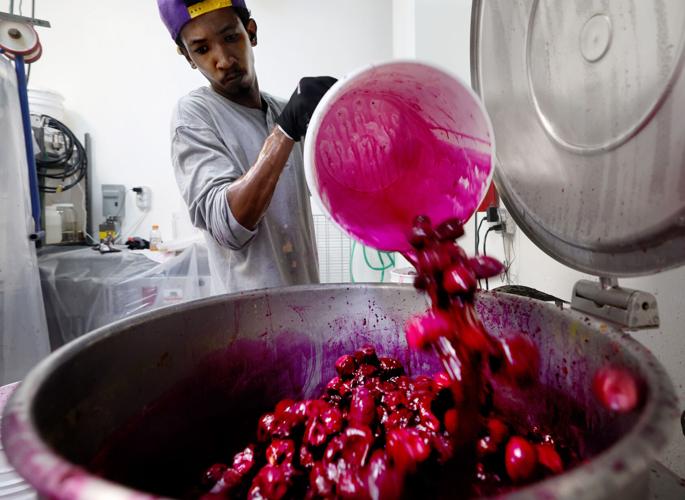Some 46 artisans produce 159 regionally unique artisanal food products, capturing the heritage and flavors that make Tucson a UNESCO City of Gastronomy.
Here are three of them.
Cheri’s Desert Harvest
In her former life teaching Tucson fourth-, fifth- and sixth-graders, Cheri Romanoski preached the gospel of how Native Americans in Southern Arizona survived on the desert’s bounty.
Yet, when she started making organic jams and jellies 39 years ago, she went to the standbys: strawberry, blueberry and blackberry to complement her gourmet mustard, pepper jellies and citrus marmalade.
“Everything grew in my yard, other than the berries,” the Tucson native recalled.
By year four, Romanoski had a bit of an epiphany. She looked out onto that desert bounty and wondered why she wasn’t looking there for inspiration.
That’s when she pivoted to only using Indigenous vegetables and fruits, including the red bulbous prickly pear fruit growing on top of the flat-pads of the cacti found in abundance here.
She turned that fruit into cactus marmalade, jelly and prickly pear cactus syrup to go with a variety of branded mixes for pancakes, cookies, muffins and fry bread.
“That’s when it really took off because no one was working with prickly pear fruit,” said Romanoski, who sources her fruit from cactus-dotted land she owns near Green Valley. “It’s sold in 48 of the 50 states.”
You can find Cheri’s Desert Harvest prickly pear cactus syrup in Whole Foods, AJ’s and Sprouts stores; gift shops at resorts and national and state parks; resorts; and on Amazon. You also can find it online at cherisdesertharvest.com.
Chilttepica

Gloria Badilla and her husband, Huemac, package chiltepins at the Cook Tucson commercial kitchen, 1702 N. Stone Ave., on June 11. The couple first started their business, Chilttepica, in 2010 and made salsa which was sold in Costco. These days, the company’s focus is chiltepins.
The husband and wife team of Huemac and Gloria Badilla launched their spice and salsa company in 2010 and for six years beginning in 2014, they found an oversized audience for the salsa courtesy Costco.
The warehouse behemoth carried the chiltepin-based salsa for six years, until it was replaced by another local product as part of Costco’s rotating regional products program.
With the COVID pandemic in full swing, the couple shelved the salsa and focused on their sun-dried chiltepin peppers, bottled whole, ground and infused in sea salt.
The smoky peppers, which the couple sources from a family farm in Hermosillo, are hotter than jalapeños but not as spicy as habaneros.
“When you eat the chiltepin, you will feel the heat on the side of your mouth and it will linger to the back of your mouth,” Gloria Badilla said. “It’s going to be hot; depending on your tolerance, you’re going to turn red. But then it will be gone.”
While chiltepins are regularly used for salsas, to spice up soups and in menudo, Badilla said one of her customers said he uses it to add heat to his pasta sauce.
You can find Chilttepica at La Estrella Bakery, Tohono Chul Park, Food Coop on North Fourth Avenue and the Del Sol Marketplace next door to Casino del Sol on West Valencia Road. Order online through chilttepica.com or through Native Seeds/SEARCH, nativeseeds.com.
Sky Island Spice Co.
Chad Borseth has gardened since he was a kid, so it probably surprised no one when he turned his passion for gardening into a business.
In 2018, Borseth, who grew up in Tucson and went to school in Patagonia not far from the Mexican border, launched Sky Island Spice Co. as an excuse to get outside more and “do some more foraging.” He was looking for those native-to-the-region plants that had informed his palate from childhood.
He started with chiltepin peppers that he found growing wild under mesquite trees. So naturally his mind wandered to smoking the peppers with mesquite.
“Chiltepin is the third most expensive spice in the world, neck and neck with cardamom,” said Borseth, whose home garden includes native squash, corn, chiles and herbs. “It’s the ancestor of all chiles.”
But the peppers are not the biggest seller for Sky Island. That would be his soup mixes — Tucson’s food heritage in a pot.
The green posole has organic blue and white posole corn, pinto beans and white bordal beans, with traditional seasonings including epazote, bay laurel, green chile and cumin, while heirloom Anasazi beans swim in a smokey blend of pasilla de Oaxaca chile and seasonings in his Anasazi bean soup.
Borseth sells his products online at skyislandspiceco.com or through Native Seeds/SEARCH (nativeseeds.org), as well as local farmers markets and other events in the fall and winter.
"Big Jim" Griffith shows us spicy chiltepin peppers and how to prepare them using a mortar and pestle.






